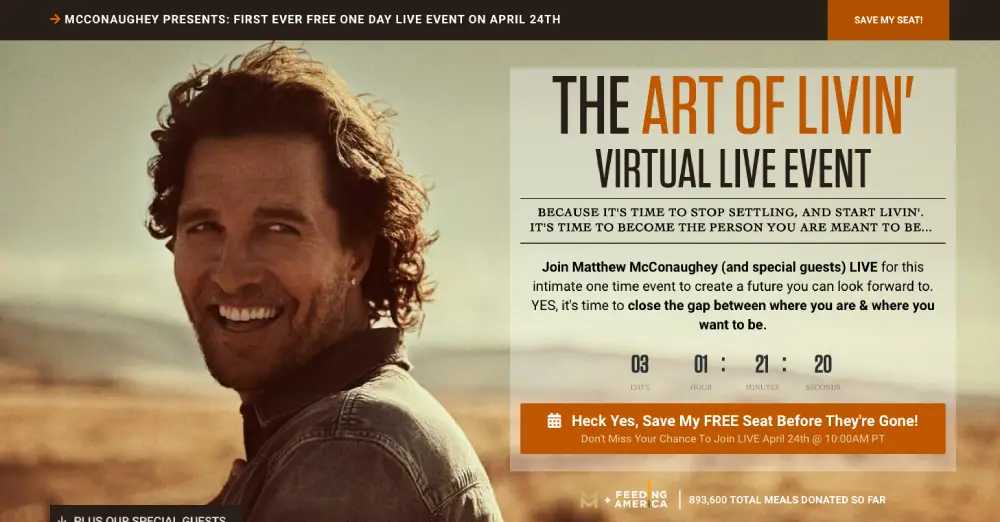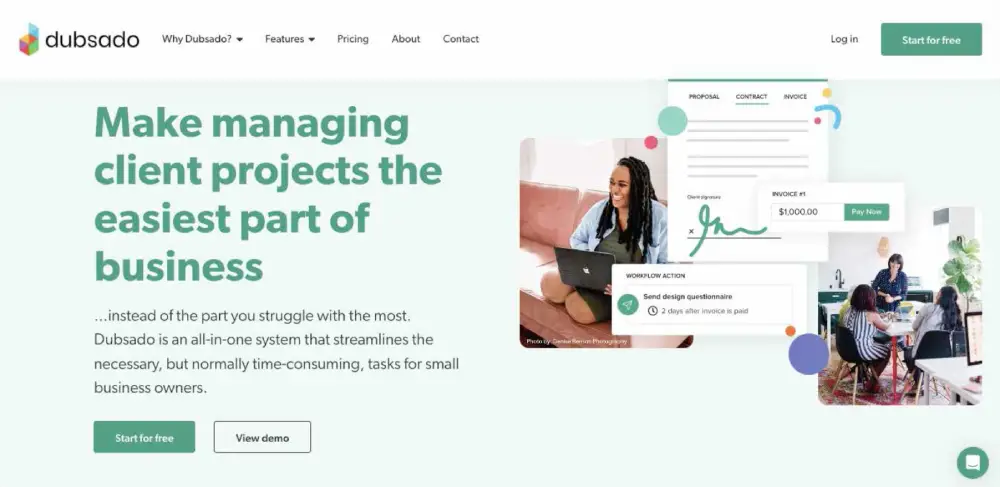Your complete guide to copywriting – and why copywriters are so important, even among new AI tools.

If you’ve found your way to this article, you’re likely curious about the art of copywriting and its role in marketing. Whether you’re interested in pursuing freelance copywriting as a career or simply want to know how to create compelling content – you’re in the right place.
I’m going to answer the fundamental question, “What is copywriting?”
At its core, copywriting persuades people to take action. Great copy is the backbone of effective marketing. It grows a brand and sells more products and services. Marketing content like websites, emails, articles, and more are all made up of copywriting.
But copywriting is a whole lot more than stringing sentences together.
Copy that drives results should:
- Connect with the audience’s emotions
- Use storytelling to paint a vision
- Answer questions
- Guide a reader into a decision that’s right for them
Stick around if you’re ready to learn more about this whole process.
I. What Is Copywriting – And What Does a Copywriter Do?
II. The Four Fundamentals of Effective Copywriting
III. Types of Copywriting and Copywriting Examples
IV. The Importance of Copywriters (Even With AI Tools)
By the end of this article, you’ll have a solid understanding of copywriting definitions. Plus, how to use the written word to earn more money for your clients’ brands.
I’m Sarah, a freelance medical copywriter for over ten years and a copywriting mentor that’s helped thousands of students create lucrative freelance copywriting careers. Everyone starts where you are now by learning what copywriting is – so let’s dive in!
Learn How to Build a Lucrative Freelance Copywriting Career
Get my free copywriting masterclass that walks you through exactly how I went from zero to consistent five-figure months with copywriting – with no experience and no portfolio.
Gain instant access – right to your inbox – when you sign up below. 👇
We will never spam you or share your email with anyone. In addition to the guide you’ll also receive semi-regular email updates with tips, tools, offers and exclusive resources. All emails include an unsubscribe link, you may opt-out at any time. Read our Privacy Policy to see how your data is handled.
What Is Copywriting – And What Does a Copywriter Do?
Copywriting is everywhere. You likely interact with copywriting on a *daily* basis online. But maybe you’ve never known that what you’re reading is actually copywriting.
Think about the last time you made a purchase online. The product’s website or description included carefully crafted copy that spoke directly to your desires and needs.
Maybe it helped you envision how you would use the product in your daily life. Then it enticed you to buy with a compelling call to action. All of this is effective copywriting at play.
Here’s a copywriting definition: copywriting refers to the text or words used in marketing materials – the content that a brand uses to promote themselves. This includes everything from a brand’s tagline and website to the words used in every advertisement.
Here are a few examples of marketing materials that include copywriting:
- Website and branding
- Blog articles
- Email marketing
- TV and radio ads
…and much, much more.
Copywriting has been around for centuries. From the first documented piece of copy in ancient Egypt to the “Mad Men” golden age of advertising in the 50s to the present day. Copywriting has become even more significant in the last decade with the rise of content marketing.
Content marketing focuses on creating highly valuable, informative, and relevant content.
The goal is to demonstrate credibility, build trust, and create a relationship with the audience – before eventually driving a sale. This strategy has become increasingly important because customers have so many different brands to choose from these days.
Did you know 82% of consumers think more positively about a company after reading custom content? And 78% say that reading content helps them create a relationship with the brand.1
The problem is – creating compelling, effective content takes time and a specific skill set. Many brands don’t have the time or expertise to create this content themselves.
That’s where a freelance copywriter comes in.
Brands contract freelance copywriters to create content for them. As a freelancer, you partner with various clients and write their marketing materials for them.
You might work on one specific project for the brand, like writing their blog content. Or you could take the entire marketing funnel off their plate every month. Tackling different elements of the funnel increases the value of the project – and your total rate for a project! 🥳
That’s exactly how I ended up landing a $21,000 retainer with one of my clients. I handled their entire sales funnel, which included pieces like ad copy, opt-ins, email sequences, and a sales page – and it generated millions of dollars in revenue.
Learning how to write effective copy that drives results is a highly valuable skill. So many brands and entrepreneurs need copywriters who understand what types of content will help them grow – and then bring that vision to life with compelling content.
The Four Fundamentals of Effective Copywriting
There are many types of copywriting with different lengths and placements. We’re going to go over specific copywriting examples in the next section. But if you’re new to the craft, it’s essential to understand the fundamentals of effective copywriting in general.
Let’s start by talking about the sales funnel phases that a customer goes through before they decide to take action or purchase a product:
- Awareness/Attention: The first step is for the customer to become aware of a specific offer. You want to grab the reader’s attention to compel them to keep reading. This might look like a catchy subject line or a bold opening statement.
Most people refer to the opening line of copy as the “hook.” This is the statement that gets the reader to stop and pay attention to the copy.
- Interest: Once you have the reader’s attention, it’s time to build their interest. This is where you provide more information on the topic or offer you’re writing about. The goal is to keep the reader engaged and reading through the copy.
The interest phase is a great place to evoke emotional storytelling. You could paint a picture of what the audience’s life looks like without the problem they’re going through. Or perhaps you tell a personal story that illustrates your point.
- Desire/Decision: After you’ve built interest, it’s time to create a desire for the product or service. This is generally where you introduce the offer as the solution to the problem you might’ve talked about in the interest phase.
At this point, the customer may decide they want to pursue the solution you’re offering. Now, it’s time to show them why they should choose the specific offer you’re promoting over other solutions on the market.
- Action: The last step is to provide a clear and compelling call to action that encourages the reader to take the next step. You might think this would happen automatically if the reader is interested. But you actually need to tell them exactly what to do next.
This is the difference between copywriting vs. content writing. Content writing aims only to educate and inform. And while copywriting might educate, it also always encourages the reader to take action.
These are the four general steps a person goes through before deciding to take action. The goal of your copywriting is to meet the audience where they are in that decision-making process – and move them toward the next step.
That’s why copywriting is an art and a science. It’s more than just putting words on paper. Effective copywriters understand the skills and techniques to compel the reader to take action. All while infusing storytelling, brand voice, persuasion techniques, and more.
For a deeper dive into developing copywriting skills and techniques, check out this article.
Types of Copywriting – and Copywriting Examples
There are many types of copywriting that you can specialize in as a freelance copywriter. And you don’t need to offer *every* single type of copywriting to succeed. In fact, it’s best to focus on the services you genuinely enjoy and excel at. So, where do you get started?
Here are some of the many different types of copywriting to explore:
1. Direct-Response Copywriting
Direct-response copywriting focuses on getting an immediate response from the reader. The goal is to persuade the reader to take action right away. Whether it’s buying a product, signing up for a service, or taking the next step in the sales funnel.
Here’s an example of direct-response copy. This opt-in form is a landing page with one goal: to get the reader to sign up for the virtual event.

Direct-response copywriters use powerful language and strong calls to action (CTAs) to motivate readers to act quickly. This skill is highly valuable because it leads to higher conversion rates, sales, and revenue for the client.
2. Search-Engine-Optimization (SEO) Copywriting
SEO copywriting involves strategically creating content that ranks well in search engines like Google. SEO copywriters use specific keywords and phrases throughout their content and meta descriptions to help it rank higher in search results pages.
This article you’re reading now is an example of SEO copywriting. The topic is a subject that our audience (that’s you!) might be searching for. This article aims to answer your questions and provide helpful value.
SEO is a proven way to help brands grow through organic search. This type of content helps potential customers find and purchase from the brand without relying on paid advertising. SEO is pretty confusing to many – so if you can master this skill, you’ll have a valuable service to offer.
3. Social Media Copywriting
Social media has become an essential part of marketing strategies for businesses. Social media copywriters create engaging posts that resonate with the target audience on platforms like Facebook, Twitter, Instagram, LinkedIn, and more.
LinkedIn is a powerful tool for creating a following and connecting with potential clients. In fact, it’s 277% more effective for client acquisition than FB and Twitter. You can use LinkedIn to grow your own brand or offer LinkedIn writing as a service to your clients.2
4. Email Marketing Copywriting
Email marketing is one of the most effective ways for brands to connect with their customers and compel them to purchase. Email marketing copywriters write newsletters, emails, and sequences that each have specific goals.
Here’s an example of email copywriting. This welcome email tells the reader exactly how Fellow can help them and what to do next.

Email is such an essential and robust piece of a brand’s marketing strategy that you could create an entire freelance copywriting career focused on email alone. If you’re interested in offering email marketing, the e-commerce niche is a great place to start.
5. Launch Copywriting
Launch copywriting is marketing copy that a brand uses to launch and sell a new product or service. This usually includes ad copy, sales emails, and sales pages.
The primary goals of launch copywriting are to generate buzz, excitement, and anticipation around the launch. But most of all, drive conversions once the offer is available.
For example, maybe you write the launch email sequence that gets the audience excited about the new offer and drives them to the sales page. You could also create the sales page that walks them through the offer and finally compels them to purchase.
6. White Paper Copywriting
A white paper is a persuasive and authoritative document that typically offers a deep analysis of a particular issue or presents a solution to a complex problem. White papers are commonly used in Business-to-Business (B2B) marketing to showcase a company’s thought leadership and expertise in a particular field.
Although white papers appear to be research pieces, they’re actually marketing tools. They demonstrate a brand’s knowledge of a subject before persuading the reader to take action.
If you enjoy doing extensive research on a topic and writing long-form copy, you might want to experiment with offering white papers as a freelance copywriter.
7. Website and Branding Copywriting
Defining a brand’s unique voice, value proposition, and messaging is a crucial step in marketing. Brands that stand out have a unique voice and vision for the company.
Here’s an example of website and branding copywriting. This headline communicates the brand’s value in a unique way while also making their offer crystal-clear.

Brand messaging is a valuable skill for a freelance copywriter. You can help your clients take their personality, voice, and vision for their company to create a brand persona that sounds like them. This, in turn, attracts their audience.
This is actually a shortlist of all the different types of copywriting that exists. You could also offer case study copywriting, product descriptions, and so much more.
Many copywriters ask me, “Do I need to offer ALL different types of copywriting?” and the answer is no. You can choose which types of copywriting you specialize in – based on which ones you enjoy working on.
If you’re just starting out, I recommend experimenting a bit. The best way to learn what types of copywriting you enjoy is to work with clients, take on a few projects, and see what you like.
Copywriters also often ask me how the advancement of AI is impacting the future of the copywriting industry. It’s no secret AI has become quite the buzz lately. So here are my thoughts on its significance to copywriters like us.
The Importance of Copywriters (Even With AI)
With all the advancements in artificial intelligence (AI), you might be wondering: is AI going to replace copywriters? And it’s a fair question, given all the hubbub about AI recently.
While these tools are becoming more advanced, there are still a lot of limitations of AI tools compared to a human copywriter.
AI has a hard time replicating the persuasive techniques, empathy, and storytelling that make copywriting effective. And getting AI to write your content requires a deep understanding of what to input into the platform.
While some brands might use AI to DIY their content – many still want to work with copywriters that deliver strategy, skill, and results for their clients. Because they know that human interaction is what sets their brand apart and genuinely connects with their audience.
Positioning yourself as a partner and marketing strategist sets you apart as a freelance copywriter. AI helps with strategy if you know exactly what to ask for. But many clients don’t know what to ask for in the first place and don’t have the desire to learn AI.
The best way to think about AI as a copywriter is to embrace the technology and keep an open mind. You can explore how it could help you make your process more efficient and effective.
How to Earn $10k Months as a Copywriter
Copywriting is a critical piece of helping a brand grow. All brands need compelling and persuasive content to grow their audience and generate revenue. But finding effective freelance copywriters that deliver results is more challenging than it seems.
That’s why freelance copywriting is such a lucrative career.
You only need a handful of clients to start earning $5k, $10k, or even $20k per month as a freelance copywriter. But you get there so much faster with proven support and a roadmap.
Looking for that effective roadmap? Check out my free copywriting masterclass:
Learn How to Build a Lucrative Freelance Copywriting Career
Get my free copywriting masterclass that walks you through exactly how I went from zero to consistent five-figure months with copywriting – with no experience and no portfolio.
Gain instant access – right to your inbox – when you sign up below. 👇
We will never spam you or share your email with anyone. In addition to the guide you’ll also receive semi-regular email updates with tips, tools, offers and exclusive resources. All emails include an unsubscribe link, you may opt-out at any time. Read our Privacy Policy to see how your data is handled.
If you’re ready to learn the answers to “What is copywriting?” and “How do I make 6+ figures as a copywriter?” this is the masterclass for you. I can’t wait to help you demystify how to become a high-earning copywriter.
Resources:







